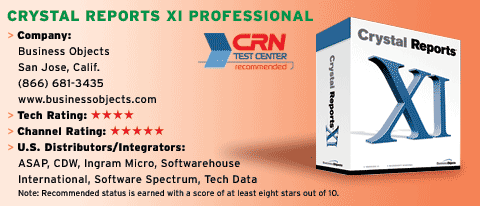Crystal-Clear Winner: Report Writer Is Tops
Version XI features cascading prompts and better exporting configurations, including RTF exports, HTML previews, a workbench and enhanced sorting functions. Report prompts, which help users interact with reports at each execution, no longer must be placed into static lists. Prompt definitions now can be shared among multiple reports, simplifying the design process.
Sorting group values now can have their own formulas, with sorted reports being consolidated via a parameter mechanism. Sorting formulas used in parameters allow users with different sorting requirements to access the same report. This feature reduces the number of reports that need to be maintained.
Crystal Reports' new HTML WYSIWYG preview feature speeds development time because it eliminates the step of having to publish reports every time an update is made to a design. Version XI has introduced an automated method of adding report data into charting and cross-tab features without having to create any links to these features. Charts and cross tabs can now be generated automatically during the design process.
The start page's clean design borrows the open Web-like user interface concept found in some of Microsoft's server user interfaces. The page provides easy access to every major feature, including online help, support, updates and training. Update patching is now automated. Users can also run searches for resources and work on sample reports. By default, Crystal Reports' Workbench is on the right side of the main pane, so users can easily jump between projects while accessing the main workspace.
Through a native XML driver, Version XI can convert raw XML files into formatted reports and even transform XML into other formats such as HTML and WML. The driver accepts both DTD (Document Type Definition) and schemas, and works on top of Java's J2SE 1.4 SDK. The software also arrives with a DataDirect that accepts XML over ODBC data sources. This access is limited to specific structures but can accept multiple file types such as data island files, ADO (ActiveX Data Objects) and hierarchical formatted files.
Crystal Reports' Report Designer has not changed too much since the last time CRN Test Center engineers examined the product. Arranging report sections is still done the same way. The Section Expert breaks each section's properties neatly and connects each property in a section to a Formula Editor command in the Formula Workshop. The connection between design and formula helps developers to associate code with visual effect. Crystal Reports has come a long way since the days it associated formulas with report fields directly. Its new Formula Editor breaks down all the coding aspects of a report into formulas, formats, SQL expressions and functions.
By separating each procedure into a well-defined step, Crystal Reports has simplified how formulas and functions interact with reports. In the formatting Formula Editor, for instance, developers can add code to each report section, including code that can change behavior based on input data, or even change the look and feel between sections. Crystal Reports has become an event-driven platform.
Crystal Reports' OLAP Expert in Report Designer provides six steps for processing OLAP cubes. The software provides OLAP connectivity to IBM's DB2 OLAP Server, Hyperion Essbase, Holos HDC Cube and Microsoft's OLAP Services. In addition to OLAP server connectivity, Crystal Reports provides direct access to OLAP cubes on local files and distributed as HTTP cubes. By allowing access to cube files, Crystal Reports provides better access to OLAP data outside of supported servers. Crystal Reports separates OLAP dimensions into tree structures, allowing report designers to work with OLAP data in the same way as relational data.
Within the function repository, developers now can add custom Java functions. This signifies that any data accessed from Java-based applications using Enterprise JavaBeans or Java message queues now can be used by Crystal Reports. Java Server Faces are now also available through a new JSF developer kit. Crystal Reports provides a full programmatic control of every function through its API.
Business Objects provides online development zones for every programming model that Crystal Reports supports. Crystal Reports' average reseller margin is 27.5 percent for all partners. To sell Crystal Reports, resellers are required to meet annual revenue commitments, pay annual fees and commit to presales training activities. Additional support includes marketing collateral, discretionary market development funds, merchandise and access to a dedicated partner extranet.
Business Objects has an outstanding technical support program with dedicated account managers and marketing support. The company provides extensive training and certification programs, designed for every level of expertise. In addition, Business Objects has online courses that provide partners with training at any time. Crystal Reports XI Professional is priced at $495 per user.
